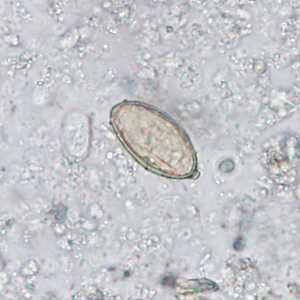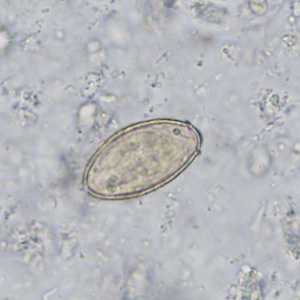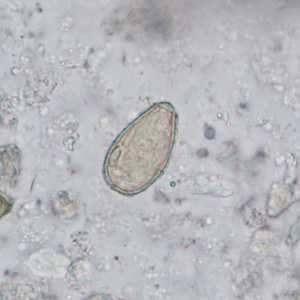
Case #402 - August 2015
A stool specimen was collected from a 28-year-old man from China as part of a refugee health screening program. The stool was collected in 10% formalin and a formalin-ethyl acetate (FEA) concentration was performed. A wet mount smear was prepared from the sediment and examined for parasites. Figures A-C show what was observed at 400x magnification; the objects of interest measured 25-30 micrometers long. What is your diagnosis? Based on what criteria?

Figure A

Figure B

Figure C
Case Answer
The objects shown were the eggs of either Clonorchis sinensis or Opisthorchis sp., which are two genera of liver flukes. Eggs of these opisthorchids are nearly indistinguishable from each other by morphology, and examination of adult worms is needed to make a species-level identification. Morphologic features shown included:
- small eggs in the size range consistent with opisthorchid trematodes (25 to 33 micrometers).
- the presence of an operculum with protuberances usually referred to as “shoulders.”
- the presence of an abopercular knob (clearly shown in Figure A, less so in Figure B).
More on: Clonorchiasis
More on: Opisthorchiasis
Images presented in the monthly case studies are from specimens submitted for diagnosis or archiving. On rare occasions, clinical histories given may be partly fictitious.
DPDx is an education resource designed for health professionals and laboratory scientists. For an overview including prevention and control visit www.cdc.gov/parasites/.
- Page last reviewed: August 24, 2016
- Page last updated: August 24, 2016
- Content source:
- Global Health – Division of Parasitic Diseases and Malaria
- Notice: Linking to a non-federal site does not constitute an endorsement by HHS, CDC or any of its employees of the sponsors or the information and products presented on the site.
- Maintained By:


 ShareCompartir
ShareCompartir